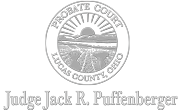History of the Probate Court
The term "probate" comes from the Latin word probatio, meaning, "to prove," wherein matters in early English religious courts were proven before an ecclesiastical judge. Early American probate courts may be traced back to English courts of chancery and ecclesiastical, or religious, courts, which had jurisdiction over the probate of wills, administration of estates and guardianships.
The first probate court in the United States was established in Massachusetts in 1784. Similar courts were subsequently established in other states under the name of surrogate, orphan courts, or courts of the ordinary. The Northwest Ordinance of 1787 provided for the first probate judge and court in the Ohio territory. Under the first Ohio Constitution written in 1802, the court of common pleas had exclusive jurisdiction of probate matters.
The constitution of 1851 removed probate matters from the jurisdiction of common pleas courts and created in each county a separate probate court. Subsequent amendments to the constitution in 1912, 1951, 1968, 1973 and changes in the codified law in 1932 and 1976 have made the probate court what it is today: a special division of the court of common pleas. Each of Ohio's 88 counties has a probate division of its court of common pleas.
